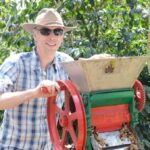
Last week’s meeting with Congressman Earl Blumenauer brought a couple of esteemed members of the Oregon wine industry in to meet with the local coffee roaster and retailing community. The Congressman had said in prior Roasters Forums that he felt there were a lot of similarities between the two groups of people and that they had a lot to share with each other. Sam Tannehill from A to Z Wineworks and Rex Hill Vineyard and Susan Sokol Blosser from Sokol Blosser Winery spoke about how the industry started from almost nothing, grew exponentially, and became an internationally-recognized producers of premium wines.

The Oregon wine industry today is strong and thriving with more than 460 active wineriers and 1600 vineyards. While the Rouge River and Umpqua River valleys in the southern part of the state have been growing wine grapes for a longer period of time than most of the Willamette Valley vineyards (which are nearby Portland and an easy visit if you’re in town to see any number of terrific coffee shops and roasters). It’s the Willamette Valley vineyards that have been instrumental to building a national and international reputation for excellence particularly for pinot noirs.
“We were liberal arts majors,” Susan Sokol Blosser said.. “We had no background in agriculture, so we should give hope to all struggling entrepreneurs.” Indeed, they should. When Sokol Blosser started her eponymous vineyard and winery (now run by her children), 26 years ago, the Oregon wine industry was in its nascent phase. Today it grosses more than $2.8 billion a year! And the number one reason for that growth, according to Sokol Blosser, was the willingness of everyone to be willing to collaborate with each other.
The Dundee Hills (about an hour southwest of Portland) are fantastic for growing the delicate and finicky pinot noir grapes. In fact they reminded Sokol Blosser so much of the hills in Burgundy, France, that’s why she originally planted the grapes there. But being finicky, the grapes needed more knowledge than Sokol Blosser had to produce their best crop. So, she and some other growers in the region though, “Why not have a contest or conference for them?” They would invite producers from France and from California, and they could all talk, share information, and everyone could improve the ultimate product. What she discovered, however, was that the long-time producers of France and California had never shared information with each other. She said, that a grower she talked to in France said, “Are you kidding? We don’t even talk to each other and you want us to work together?”
But working together was of vital importance for Oregon growers. As Sam Tennhill said, the realization was “Oregon is never going to compete in the wine business based on quantity. It has to be on quality.” But in order for that to work, everyone had to be in the same boat (and recognize that). So the growers made their own organization, the Oregon Wine Board, and they taxed themselves to fund it. They pushed for environmental standards and labeling standards. So that the wines produced in Oregon would carry a brand with them, no matter where they were sold. And all the wines would help reinforce that brand, so that Oregon would come to mean something in the minds’ of consumers. And that “something” would be small, local, family, and the highest quality.
If you’re reading this, you probably work in specialty coffee, and the similarities between the two must already be obvious, most specifically, differentiation based on quality over quantity.
But also collaboration. One of the coolest things Tannehill talked about was the Steamboat Pinot Noir conference. At the conference, growers now come from around the world and they bring their mistakes. All the participants do over the course of the conference is taste and talk about how they messed up. They share their failures so they, and others, can learn from them.
The wine industry also teamed up with Oregon State University to do research. The school now has an agriculture and food service research branch that was an offshoot of the work it did with the wine industry that does work on wine, beer, cheese, and all delicious and fermented things and a specific Oregon Wine Research Institute.
The three summary points Sokol Blosser and Tannehill said would be:
1. A rising tide lifts all boats. “Don’t look at yourself as large or small,” said Tannehill. “Look at Robert Modavi, he was relentless about promoting Napa Valley wines, and he would always talk Napa first.” Building that brand and that community in turn helped his wines, but also all Napa Valley wines because it built a base of knowledge in consumers.
2. Don’t be afraid to share. Whether it’s knowledge or equipment, a success or a failure, never be afraid to share. “It’s Ok to share it all,” he said, “because it’s ultimately all in the execution.”
3. You have a relentlessly good story: use it! “It’s so hard to do it by yourself,” Tannehill said, but you’re not by yourself. “You’re telling the Oregon story, and your story, and it’s a great story.”
These are all lessons that I think serve the specialty coffee community well. And next time you’re in this neck of the woods, I hope you take the time to visit some of the amazing vineyards and wineries nearby. There’s so much to share and learn.

